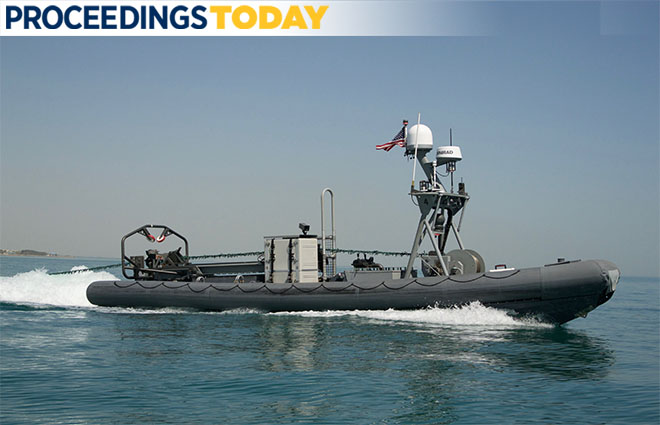
The Navy would never sail a rudderless ship, or send a ship to sea without a captain, or rely on outdated navigational charts. So why are the Navy’s current efforts to develop and acquire autonomous surface and underwater systems so disorganized?
Unmanned surface vehicle (USV) and unmanned underwater vehicle (UUV) development lags years behind unmanned aerial vehicles (UAVs). Yes, the marine environment is harsh, but this fails to explain why the Navy has so haphazardly pursued unmanned maritime systems.
Across the naval enterprise, many brilliant individuals are studying, researching, designing, and developing unmanned maritime systems. From engineers at the Naval Undersea Warfare Center (NUWC) to midshipmen at the U.S. Naval Academy, there is genuine interest in fielding autonomous systems. USV/UUV development efforts suffer, however, from a lack of clarity and prioritization. There is no rudder to steer enterprise-wide research and development (R&D) to success. There is no captain to provide technical oversight, dictate standards, and serve as the ultimate level of accountability. Most important, the “nautical chart” that is supposed to guide us—the 2014 Department of Defense Unmanned Systems Integrated Roadmap—fails to provide direction and prioritization for USV/UUV development. It should come as no surprise, therefore, that our progress has run aground.
These three actions could right the Navy’s effort to develop surface and underwater autonomous systems:
1. Choose and Empower the Right Leader. As the father of the nuclear navy, Admiral Hyman G. Rickover, stated, “Unless the individual truly responsible can be identified when something goes wrong, no one has really been responsible.” One officer should be responsible for all USV/UUV design, development, and acquisition within the Navy. This officer would oversee, consolidate, and be responsible for all efforts being pursued by Program Executive Office (PEO) Littoral Combat Ships, PEO Submarines, NUWC, the Office of Naval Research, the Naval Research Laboratory, and other applicable entities. He or she would possess a strong background in program management, acquisition, budgeting, and, most important, the fundamental engineering of autonomous/unmanned systems. This officer also would have budgetary responsibility for unmanned maritime system R&D and work closely with other members of the naval enterprise to pursue the most relevant science/technology.
2. Set Clear, Challenging Development Goals. A single, cohesive message for the naval enterprise that identifies clear development priorities would improve the return on the Navy’s investment. Innovation benefits from ambition and aggressiveness. The Navy should set tangible goals for industry and establish challenging timelines for achieving these goals. Instead of acknowledging that vehicle endurance is a difficult problem, the Navy should define an actual goal. For example, state that within the next six months, private industry will design and prototype a self-sufficient energy subsystem capable of powering a large displacement unmanned underwater vehicle for 100 days.
3. Leverage Existing Passion. Among the Navy’s sailors and officers are gifted computer programmers, talented ship designers, and skilled unmanned vehicle operators. The Navy must leverage this knowledge to advance its R&D efforts. Naval Academy midshipmen could help design, develop, and prototype unique unmanned maritime systems. Sailors who have worked with unmanned systems could serve as test engineers and operators for USV and UUV prototypes. Feedback from the fleet must rapidly be integrated into future developmental activity.
The Navy must raise the priorities for unmanned surface and underwater vehicle development. USVs and UUVs will be critical elements in future naval warfare. With steady effort under resolute leadership, the Navy could have the world’s best unmanned, autonomous force.
Lieutenant Laun is a submarine warfare officer currently assigned as an instructor in the Naval Architecture & Ocean Engineering Department at the U.S. Naval Academy. He previously served on board the USS John Warner (SSN-785).



